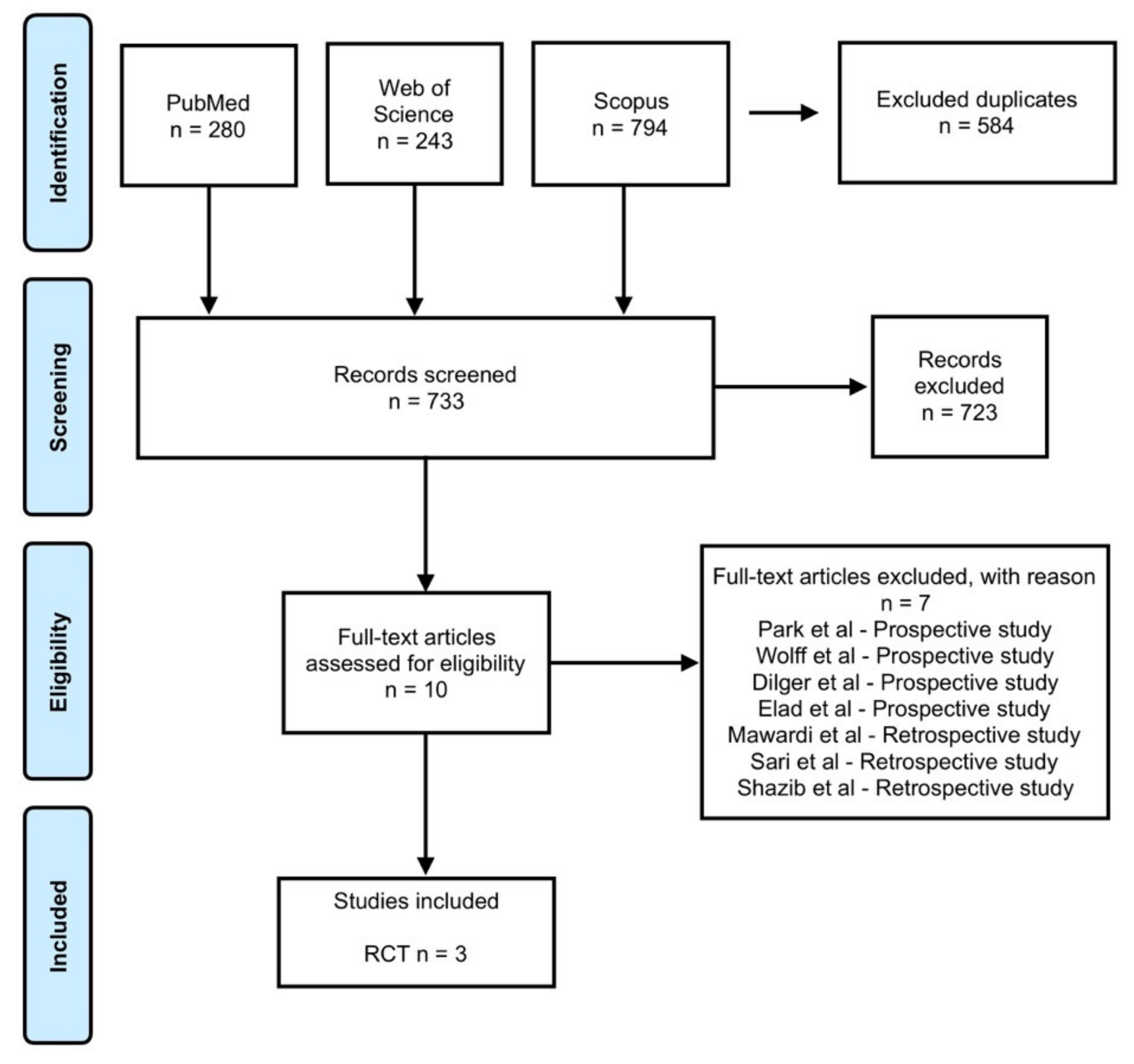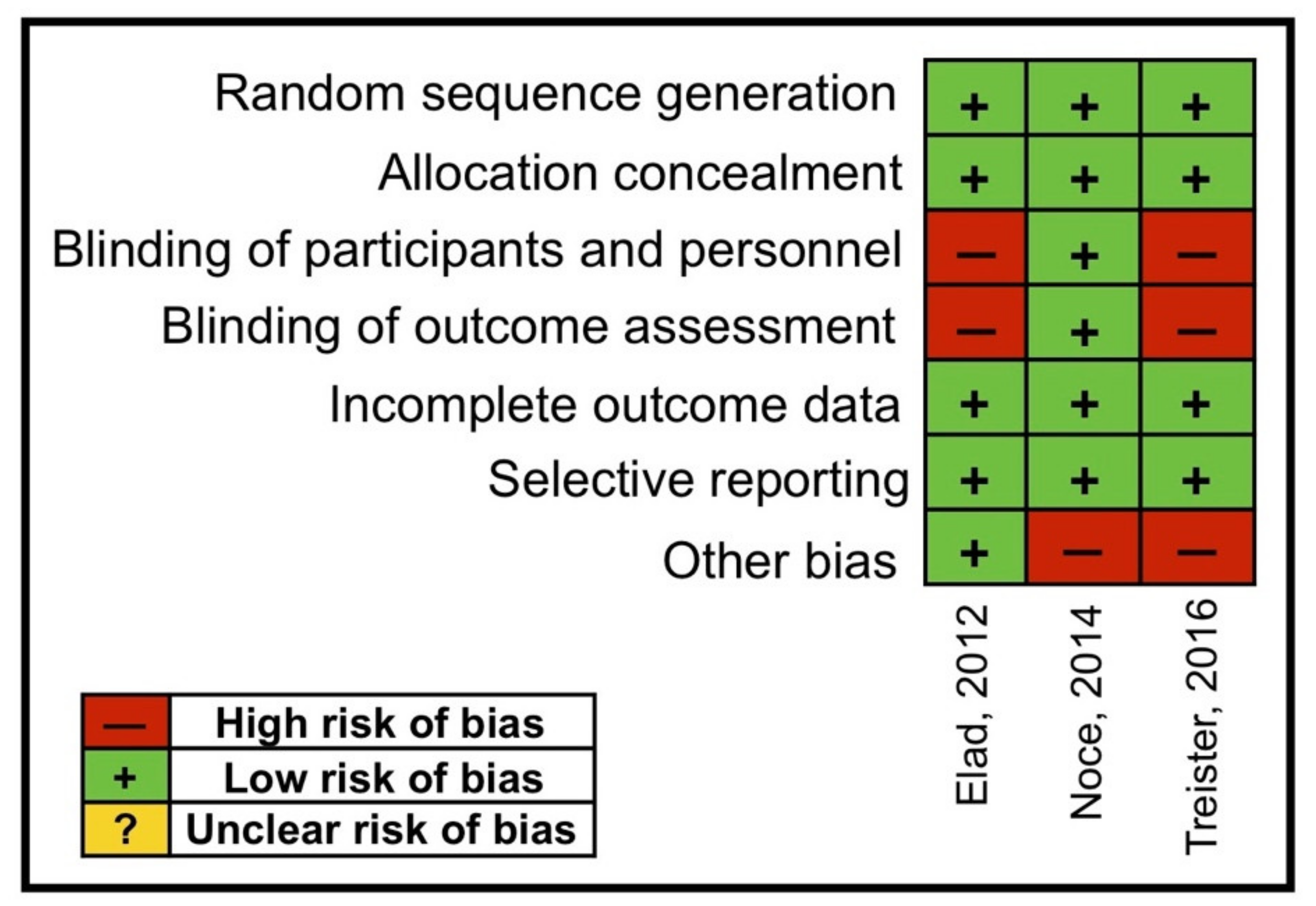Topical Corticosteroids a Viable Solution for Oral Graft versus Host Disease? A Systematic Insight on Randomized Clinical Trials
Abstract
1. Introduction
2. Materials and Methods
3. Results
4. Discussion
5. Conclusions
Author Contributions
Funding
Conflicts of Interest
References
- Markey, K.A.; MacDonald, K.P.A.; Hill, G.R. Impact of cytokine gene polymorphisms on graft-vs-host disease. Tissue Antigens 2008, 72, 507–516. [Google Scholar] [CrossRef]
- Imanguli, M.M.; Alevizos, I.; Brown, R.; Pavletic, S.Z.; Atkinson, J.C. Oral graft-versus-host disease. Oral Dis. 2008, 14, 396–412. [Google Scholar] [CrossRef] [PubMed]
- Nicolatou-Galitis, O.; Kitra, V.; Van Vliet-Constantinidou, C.; Peristeri, J.; Goussetis, E.; Petropoulos, D.; Grafakos, S. The oral manifestations of chronic graft-versus-host disease (cGVHD) in paediatric allogeneic bone marrow transplant recipients. J. Oral Pathol. Med. 2001, 30, 148–153. [Google Scholar] [CrossRef] [PubMed]
- Parkman, R. Chronic graft-versus-host disease. Curr. Opin. Hematol. 1998, 5, 22–25. [Google Scholar] [CrossRef] [PubMed]
- Shulman, H.M.; Sullivan, K.M.; Weiden, P.L.; McDonald, G.B.; Striker, G.E.; Sale, G.E.; Hackman, R.; Tsoi, M.S.; Storb, R.; Thomas, E.D. Chronic graft-versus-host syndrome in man. A long-term clinicopathologic study of 20 Seattle patients. Am. J. Med. 1980, 69, 204–217. [Google Scholar] [CrossRef]
- Filipovich, A.H.; Weisdorf, D.; Pavletic, S.; Socie, G.; Wingard, J.R.; Lee, S.J.; Martin, P.; Chien, J.; Przepiorka, D.; Couriel, D.; et al. National Institutes of Health consensus development project on criteria for clinical trials in chronic graft-versus-host disease: I. Diagnosis and staging working group report. Biol. Blood Marrow Transplant. 2005, 11, 945–956. [Google Scholar] [CrossRef]
- Mester, A.; Irimie, A.; Oprita, L.; Dima, D.; Petrushev, B.; Lucaciu, O.; Campian, R.-S.; Tanase, A. Oral manifestations in stem cell transplantation for acute myeloid leukemia. Med. Hypotheses 2018, 121, 191–194. [Google Scholar] [CrossRef]
- Mester, A.; Irimie, A.I.; Tanase, A.; Tranca, S.; Campian, R.S.; Tomuleasa, C.; Dima, D.; Piciu, A.; Lucaciu, O. Periodontal disease might be a risk factor for graft versus host disease. A systematic review. Crit. Rev. Oncol. Hematol. 2020, 147, 102878. [Google Scholar] [CrossRef]
- Curtis, J.W.J.; Caughman, G.B. An apparent unusual relationship between rampant caries and the oral mucosal manifestations of chronic graft-versus-host disease. Oral Surg. Oral Med. Oral Pathol. 1994, 78, 267–272. [Google Scholar] [CrossRef]
- Bollero, P.; Passarelli, P.C.; D’Addona, A.; Pasquantonio, G.; Mancini, M.; Condò, R.; Cerroni, L. Oral management of adult patients undergoing hematopoietic stem cell transplantation. Eur. Rev. Med. Pharmacol. Sci. 2018, 22, 876–887. [Google Scholar]
- Elad, S.; Aljitawi, O.; Zadik, Y. Oral graft-versus-host disease: A pictorial review and a guide for dental practitioners. Int. Dent. J. 2020. [Google Scholar] [CrossRef]
- Fall-Dickson, J.M.; Pavletic, S.Z.; Mays, J.W.; Schubert, M.M. Oral Complications of Chronic Graft-Versus-Host Disease. J. Natl. Cancer Inst. Monogr. 2019, 53, lgz007. [Google Scholar] [CrossRef] [PubMed]
- Capocasale, G.; Panzarella, V.; Tozzo, P.; Mauceri, R.; Rodolico, V.; Lauritano, D.; Campisi, G. Oral verruciform xanthoma and erythroplakia associated with chronic graft-versus-host disease: A rare case report and review of the literature. BMC Res. Notes 2017, 10, 63. [Google Scholar] [CrossRef] [PubMed]
- Albuquerque, R.; Khan, Z.; Poveda, A.; Higham, J.; Richards, A.; Monteiro, L.; Jane-Salas, E.; Lopez-Lopez, J.; Warnakulasuriya, S. Management of oral Graft versus Host Disease with topical agents: A systematic review. Med. Oral Patol. Oral Cir. Bucal 2016, 21, e72. [Google Scholar] [CrossRef] [PubMed]
- Mays, J.W.; Fassil, H.; Edwards, D.A.; Pavletic, S.Z.; Bassim, C.W. Oral chronic graft-versus-host disease: Current pathogenesis, therapy, and research. Oral Dis. 2013, 19, 327–346. [Google Scholar] [CrossRef] [PubMed]
- Shamseer, L.; Moher, D.; Clarke, M.; Ghersi, D.; Liberati, A.; Petticrew, M.; Shekelle, P.; Stewart, L.A. Preferred reporting items for systematic review and meta-analysis protocols (PRISMA-P) 2015: Elaboration and explanation. BMJ 2015, 350, g7647. [Google Scholar] [CrossRef]
- Higgins, J.P.T.; Altman, D.G.; Gotzsche, P.C.; Juni, P.; Moher, D.; Oxman, A.D.; Savovic, J.; Schulz, K.F.; Weeks, L.; Sterne, J.A.C. The Cochrane Collaboration’s tool for assessing risk of bias in randomised trials. BMJ 2011, 343, d5928. [Google Scholar] [CrossRef]
- Park, A.R.; La, H.O.; Cho, B.S.; Kim, S.J.; Lee, B.K.; Rhie, J.Y.; Gwak, H.S. Comparison of budesonide and dexamethasone for local treatment of oral chronic graft-versus-host disease. Am. J. Health Syst. Pharm. 2013, 70, 1383–1391. [Google Scholar] [CrossRef]
- Wolff, D.; Anders, V.; Corio, R.; Horn, T.; Morison, W.L.; Farmer, E.; Vogelsang, G.B. Oral PUVA and topical steroids for treatment of oral manifestations of chronic graft-vs.-host disease. Photodermatol. Photoimmunol. Photomed. 2004, 20, 184–190. [Google Scholar] [CrossRef]
- Dilger, K.; Halter, J.; Bertz, H.; Lopez-Lazaro, L.; Gratwohl, A.; Finke, J. Pharmacokinetics and pharmacodynamic action of budesonide after buccal administration in healthy subjects and patients with oral chronic graft-versus-host disease. Biol. Blood Marrow Transplant. 2009, 15, 336–343. [Google Scholar] [CrossRef]
- Elad, S.; Or, R.; Garfunkel, A.A.; Shapira, M.Y. Budesonide: A novel treatment for oral chronic graft versus host disease. Oral Surg. Oral Med. Oral Pathol. Oral Radiol. Endod. 2003, 95, 308–311. [Google Scholar] [CrossRef] [PubMed]
- Mawardi, H.; Stevenson, K.; Gokani, B.; Soiffer, R.; Treister, N. Combined topical dexamethasone/tacrolimus therapy for management of oral chronic GVHD. Bone Marrow Transplant. 2010, 45, 1062–1067. [Google Scholar] [CrossRef] [PubMed][Green Version]
- Sari, I.; Altuntas, F.; Kocyigit, I.; Sisman, Y.; Eser, B.; Unal, A.; Fen, T.; Ferahbas, A.; Ozturk, A.; Unal, A.; et al. The effect of budesonide mouthwash on oral chronic graft versus host disease. Am. J. Hematol. 2007, 82, 349–356. [Google Scholar] [CrossRef] [PubMed]
- Shazib, M.A.; Muhlbauer, J.; Schweiker, R.; Li, S.; Cutler, C.; Treister, N. Long-Term Utilization Patterns of Topical Therapy and Clinical Outcomes of Oral Chronic Graft-versus-Host Disease. Biol. Blood Marrow Transplant. 2020, 26, 373–379. [Google Scholar] [CrossRef] [PubMed]
- Elad, S.; Zeevi, I.; Finke, J.; Koldehoff, M.; Schwerdtfeger, R.; Wolff, D.; Mohrbacher, R.; Levitt, M.; Greinwald, R.; Shapira, M.Y. Improvement in oral chronic graft-versus-host disease with the administration of effervescent tablets of topical budesonide-an open, randomized, multicenter study. Biol. Blood Marrow Transplant. 2012, 18, 134–140. [Google Scholar] [CrossRef] [PubMed][Green Version]
- Noce, C.W.; Gomes, A.; Shcaira, V.; Correa, M.E.P.; Moreira, M.C.R.; Silva Junior, A.; Goncalves, L.S.; Garnica, M.; Maiolino, A.; Torres, S.R. Randomized double-blind clinical trial comparing clobetasol and dexamethasone for the topical treatment of symptomatic oral chronic graft-versus-host disease. Biol. Blood Marrow Transplant. 2014, 20, 1163–1168. [Google Scholar] [CrossRef][Green Version]
- Treister, N.; Li, S.; Kim, H.; Lerman, M.; Sultan, A.; Alyea, E.P.; Armand, P.; Cutler, C.; Ho, V.; Koreth, J.; et al. An Open-Label Phase II Randomized Trial of Topical Dexamethasone and Tacrolimus Solutions for the Treatment of Oral Chronic Graft-versus-Host Disease. Biol. Blood Marrow Transplant. 2016, 22, 2084–2091. [Google Scholar] [CrossRef]
- Elsaadany, B.A.; Ahmed, E.M.; Aghbary, S.M.H. Efficacy and Safety of Topical Corticosteroids for Management of Oral Chronic Graft versus Host Disease. Int. J. Dent. 2017, 2017, 1908768. [Google Scholar] [CrossRef]



| Author/Year/Country | Study Type | Sample Size | Oral GVHD at Baseline | Treatment Design | Clinical Response | Side Effects | Outcome |
|---|---|---|---|---|---|---|---|
| Elad et al., 2012, Israel/Germany | Open, Randomized, Multicenter | n = 18 | Oral cGVHD WHO toxicity gastrointestinal/oral—grade 1 (n = 2)—grade 2 (n = 13)—grade 3 (n = 3) mOMRS (median)—26 OMAS (median)—1.9 | Budesonide 3 mg/10 mL mouth rinse, for 8 weeks Arm A: 3 × 10 min daily Arm B: 3 × 5 min daily Arm C: 2 × 10 min daily Arm D: 2 × 5 min daily | WHO toxicity gastrointestinal/oral—61% mOMRS—61% OMAS—69% | Cheilitis, esophagitis, fungal infection, taste alteration | Topical budesonide in oral cGVHD has a safety profile. Safety analysis supports a dosing schedule of 3 mg of budesonide 3 times a day applied for 10 min in the form of a mouthwash. |
| Noce et al., 2014, Brazil | Randomized Double-Blind Clinical Trial | Clobetasol group n = 14 Dexamethasone group n = 18 | Oral lesions of cGVHD Erythema (n = 29) Atrophy (n = 26) Ulcer (n = 22) Lichen (n = 21) Hyperkeratosis (n = 19) Pseudomembrane (n = 3) Edema (n = 2) Mucocele (n = 14) | Clobetasol: patients rinsed their mouths with 5 mL of a solution of clobetasol propionate 0.05% administered with nystatin 100000 IU/mL for 28 days. Dexamethasone: patients rinsed with 5 mL of a solution of dexamethasone 0.1 mg/mL administered with nystatin 100000 IU/mL for 28 days. | In 53.9% of the cases, the use of clobetasol resulted in an improvement of at least 50% in the mOMRS total score. For dexamethasone, this result was observed in 26.7% of the patients. | Clobetasol: burning sensation Dexamethasone: burning sensation | Topical clobetasol or dexamethasone was efficacious in the reduction of symptoms related to oral cGVHD. Clobetasol was significantly more effective than dexamethasone in the symptomatic and morphologic improvement of oral lesions. |
| Treister et al., 2016, USA | Open-Label Phase II Randomized Trial | n = 26 | Oral cGVHD NIH oral cavity severity score NIH oral mucosal score NIH oral symptom scores Oral biopsies | Dexamethasone was dispensed as a commercially prepared 0.5 mg/5 mL solution; 4 rinses per day for at least 28 days. | Overall response—69% Oral Mucosal Score Response—PR (8%), NR (88%), PD (4%) NIH oral cavity response—50% | Oral cavity pain | Topical dexamethasone is safe and effective at reducing the symptoms of oral cGVHD. Dexamethasone should at present be considered for first-line topical therapy in patients with previously untreated and symptomatic oral cGVHD. |
© 2020 by the authors. Licensee MDPI, Basel, Switzerland. This article is an open access article distributed under the terms and conditions of the Creative Commons Attribution (CC BY) license (http://creativecommons.org/licenses/by/4.0/).
Share and Cite
Sava, A.; Piciu, A.; Pasca, S.; Mester, A.; Tomuleasa, C. Topical Corticosteroids a Viable Solution for Oral Graft versus Host Disease? A Systematic Insight on Randomized Clinical Trials. Medicina 2020, 56, 349. https://doi.org/10.3390/medicina56070349
Sava A, Piciu A, Pasca S, Mester A, Tomuleasa C. Topical Corticosteroids a Viable Solution for Oral Graft versus Host Disease? A Systematic Insight on Randomized Clinical Trials. Medicina. 2020; 56(7):349. https://doi.org/10.3390/medicina56070349
Chicago/Turabian StyleSava, Arin, Andra Piciu, Sergiu Pasca, Alexandru Mester, and Ciprian Tomuleasa. 2020. "Topical Corticosteroids a Viable Solution for Oral Graft versus Host Disease? A Systematic Insight on Randomized Clinical Trials" Medicina 56, no. 7: 349. https://doi.org/10.3390/medicina56070349
APA StyleSava, A., Piciu, A., Pasca, S., Mester, A., & Tomuleasa, C. (2020). Topical Corticosteroids a Viable Solution for Oral Graft versus Host Disease? A Systematic Insight on Randomized Clinical Trials. Medicina, 56(7), 349. https://doi.org/10.3390/medicina56070349






